While the cryptocurrency community has long been enthusiastic about tokenization and on-chain assets as a means of enhancing accessibility, the most significant progress has actually come from integrating cryptocurrencies with traditional securities. The recent surge in public market interest in Digital Asset Management strategies perfectly exemplifies this trend.
Michael Saylor pioneered this strategy through MicroStrategy (now renamed 'Strategy'), transforming his company into one with a market capitalization exceeding $100 billion, surpassing even Nvidia. We provided a detailed analysis of this blueprint in our article on MicroStrategy (which is an excellent reference for those new to the asset management field). The core argument of these financial strategies is that publicly issued stock can provide cheaper, unsecured leverage, which is simply not available to ordinary traders.
Recently, attention has expanded beyond Bitcoin, and Ethereum-based asset management platforms like Sharplink Gaming ($SBET led by Joseph Lubin) and BitMine ($BMNR led by Thomas Lee) are also gaining traction. But do ETH asset management platforms really make sense? As we outlined in our analysis of MicroStrategy, asset management companies are essentially trying to arbitrage the long-term compound annual growth rate (CAGR) of the underlying asset with their capital costs. In a previous article, we outlined the following argument: ETH's long-term CAGR. It is a scarce programmable reserve asset that plays a fundamental role in securing on-chain economic stability as more assets migrate to blockchain networks. This article will elaborate on why ETH assets have a directional bullish trend and provide operational recommendations for companies adopting this asset management strategy.
Acquiring liquidity: The cornerstone of asset management companies
One of the main reasons tokens and protocols seek to create these asset management companies is to provide tokens with a pathway to access traditional finance (TradFi) liquidity, especially in cases where liquidity in cryptocurrency altcoins is declining. Typically, these asset management companies obtain liquidity through three main methods. Importantly, this liquidity/debt is unsecured, meaning it is non-redeemable:
· Convertible Bonds: Raising funds by issuing debt that lenders can convert into equity and use the proceeds to purchase more Bitcoin.
· Preferred Stock: Raising funds by issuing preferred shares that pay investors fixed annual dividends.
· Market Issuance (ATM): Selling new shares directly in the public market to raise flexible, real-time funds for purchasing Bitcoin.
Why ETH convertible bonds are superior to BTC convertible bonds
In our previous article on MicroStrategy, we pointed out that convertible bonds provide institutional investors with two main advantages:
1. Downside protection with upside risk exposure: Convertible bonds allow institutions to gain exposure to underlying assets (such as BTC or ETH) while protecting their principal investment through the inherent protective features of the bonds.
2. Volatility-driven arbitrage opportunities: Hedge funds buy convertible bonds not only to gain exposure but also to execute gamma trading strategies (a type of options trading strategy primarily based on the 'Gamma' value in options Greeks to make trading decisions). They profit from the volatility of the underlying asset and its securities.
Currently, gamma traders (hedge funds) are the primary market participants in convertible bonds.
Given this, Ethereum's higher historical volatility and implied volatility compared to Bitcoin become key differentiators. ETH asset management companies reflect this higher volatility in their capital structure by issuing ETH convertible bonds (CB). This dynamic makes ETH-supported CB particularly attractive to arbitrageurs and hedge funds. Crucially, this volatility also allows ETH asset management companies to obtain more favorable financing conditions by selling CB at higher valuations.
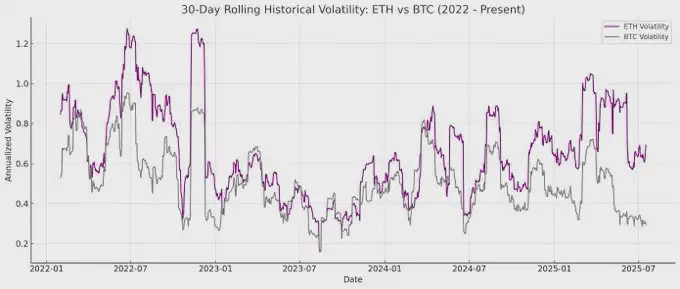
For convertible bondholders, increased volatility enhances the opportunity to profit through gamma trading strategies. In short, the greater the volatility of the underlying asset, the higher the profits from gamma trading, giving convertible bonds tied to ETH a clear advantage over those tied to BTC.
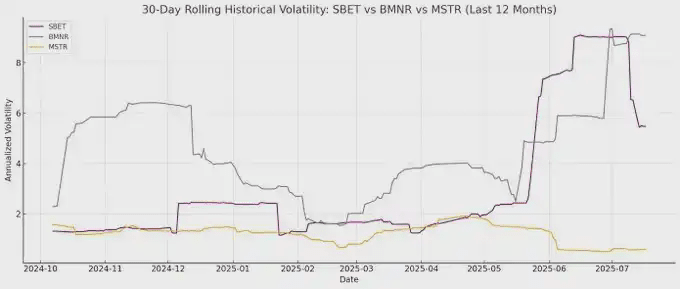
However, there is an important caveat: if ETH cannot maintain a long-term compound annual growth rate (CAGR), the appreciation of the underlying asset may not be sufficient to justify conversion before maturity. In this case, ETH asset management companies would face the risk of full bond repayment. In contrast, BTC convertible bonds—backed by Bitcoin's more mature long-term performance record—are less likely to encounter this downside risk, as historically, most convertible bonds under this strategy have been converted into equity.
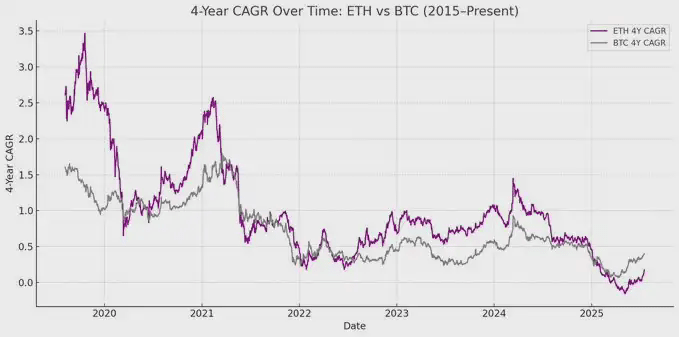
Why can ETH preferred stock provide differentiated value?
Unlike convertible bonds, the structure of preferred stock issuance targets fixed-income asset classes. While certain convertible preferred stocks offer mixed upside potential, yield remains the primary consideration for many institutional investors. The pricing of these instruments is based on the underwriting credit risk, i.e., whether the asset management company can reliably pay interest.
A key advantage of the MicroStrategy approach is the use of ATM issuance to fund these payments. Since this typically only accounts for 1-3% of total market capitalization, dilution and risk are minimal. However, this model still relies on the market liquidity and volatility of BTC and MicroStrategy's underlying securities.
Ethereum adds another layer of value: generating native yields through staking, re-staking, and lending. This built-in yield provides greater certainty for priority allocation services and should theoretically improve credit ratings. Unlike Bitcoin, which relies solely on price appreciation, Ethereum's return characteristics combine compound annual growth rates with native yields at the protocol layer.
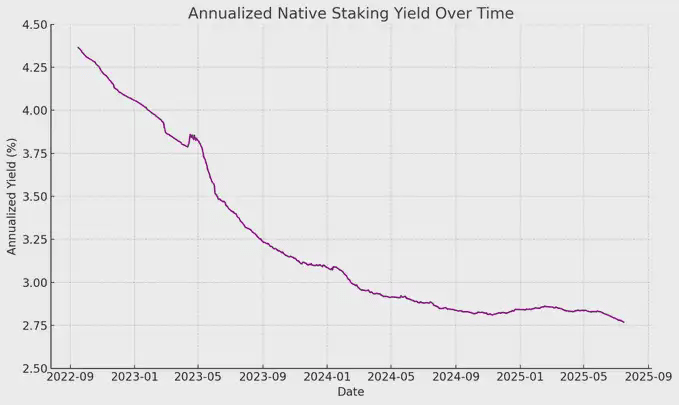
I believe one of the compelling innovations of ETH preferred stock is its potential to serve as a non-directional investment tool, allowing institutional investors to participate in network security without assuming directional risk on ETH prices. As we emphasized in our ETH report, maintaining at least 67% honest validators is crucial for securing Ethereum. As more assets migrate on-chain, it becomes increasingly important for institutional investors to actively support Ethereum's decentralization and security.
However, many institutions may not want to hold a long position in ETH directly. ETH asset management companies can act as intermediaries, absorbing directional risks while providing institutions with fixed-income-like returns. The preferred shares issued by the following institutions, $SBET and $BMNR, are designed as on-chain fixed-income staking products for this purpose. They can be enhanced through bundled advantages such as priority inclusion and protocol layer incentives, making them more attractive to investors seeking stable returns without taking on full market risk.
Why ATM issuance is more favorable for ETH assets
One of the most commonly used valuation metrics in financial companies is mNAV (market multiple to net asset value ratio). Conceptually, mNAV functions similarly to the price-to-earnings ratio: it reflects how the market prices future per-share asset growth.
Due to Ethereum's native yield mechanism, ETH assets inherently guarantee a higher net asset value premium. These activities generate recurring 'yields' or enhancements to the per-share value of ETH without incremental capital. In contrast, BTC asset management companies (BTC assets) must rely on synthetic yield strategies, such as issuing convertible bonds or preferred stock. Without these institutional products, it is difficult for BTC asset yields to be reasonable when the market premium approaches the asset's net asset value (NAV).
Importantly, mNAV is reflexive: a higher mNAV allows asset management companies to raise funds more effectively through ATM issuance. They issue shares at a premium and use the proceeds to purchase more underlying assets, thereby increasing per-share assets and reinforcing the cycle. The higher the mNAV, the greater the value obtained, making ATM issuance particularly effective for ETH asset management companies.
Acquiring capital is another key factor. Companies with stronger liquidity and broader financing capabilities naturally have higher mNAV, while companies with limited market access often trade at a discount. Therefore, mNAV typically reflects a liquidity premium—the market's confidence in the company's ability to effectively acquire additional liquidity.
How to screen asset management companies from first principles
A useful mental model is to view ATM issuance as a way to raise funds from retail investors, while convertible bonds and preferred stocks are typically designed for institutional investors. Therefore, the key to a successful ATM strategy lies in establishing strong retail influence, which often depends on having a trustworthy and charismatic leader and a consistently transparent strategy, so that retail investors believe in the long-term vision. In contrast, successfully executing convertible bonds and preferred stocks requires strong institutional sales channels and relationships with capital markets departments. Based on this logic, I believe $SBET, as a more robust retail-driven company, primarily owes its success to Joe Lubin's leadership and the team's consistent transparency regarding per-share ETH accumulation. Meanwhile, $BMNR, under the leadership of Tom Lee, seems better positioned to leverage institutional liquidity due to its close ties with traditional finance.
Why are ETH assets so important to the ecosystem and competitive landscape?
One of the biggest challenges facing Ethereum is the increasing centralization of validators and staked ETH, particularly in liquid staking protocols like Lido and centralized exchanges like Coinbase. ETH asset management companies can help balance this trend and promote validator decentralization. To support Ethereum's long-term resilience, these companies should diversify their ETH across multiple staking providers and operate their own validators whenever possible.
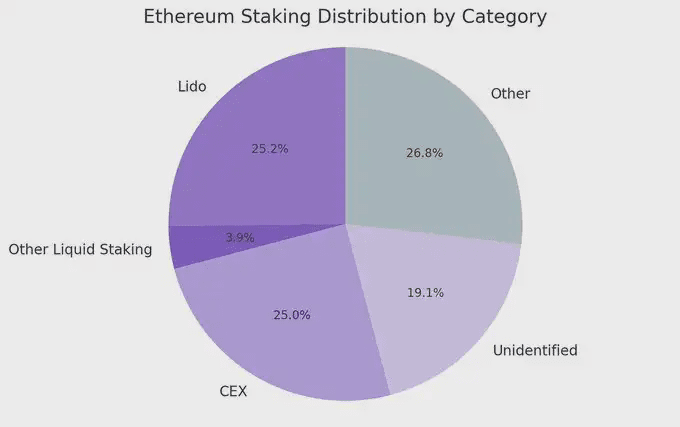
In this context, I believe the competitive landscape for ETH asset management companies will be vastly different from that of BTC asset management companies. In the Bitcoin ecosystem, the market has evolved into a winner-takes-all dynamic, with MicroStrategy holding more than ten times the amount of BTC compared to the second-largest holder. With first-mover advantage and strong narrative control, MicroStrategy dominates the convertible bond and preferred stock markets.
In contrast, Ethereum's assets start from scratch. No single entity currently dominates; rather, multiple ETH assets are being launched simultaneously. This lack of first-mover advantage is not only more beneficial for the network but also fosters a more competitive and faster-developing market environment. Given the relatively close holdings of ETH among major players, I believe we are likely to see a duopoly emerge between the two giants, $SBET and $BMNR.

Valuation: MSTR + Lido Comp
Broadly speaking, the ETH financial model can be viewed as a fusion of MicroStrategy and Lido, designed specifically for TradFi. Unlike Lido, ETH asset management companies have the potential to capture a larger share of asset appreciation due to their ownership of the underlying asset, making this model more advantageous in terms of value accumulation.
A rough valuation perspective: Lido currently manages about 30% of the total ETH staked, with an implied valuation exceeding $30 billion. We believe that within a market cycle (4 years), $SBET and $BMNR are very likely, as shown by MicroStrategy's growth strategy, to potentially surpass Lido's scale due to the speed, depth, and reflexivity of capital flows in TradFi.
Background: The market capitalization of BTC is $2.47 trillion, while ETH's market capitalization is $428 billion (accounting for 17-20% of BTC). If $SBET and $BMNR are approximately 20% of MicroStrategy's $120 billion valuation, this implies a long-term value of about $24 billion. Currently, the total valuation of the two companies is slightly below $8 billion, indicating significant growth potential as ETH assets mature.
Conclusion
The integration of cryptocurrencies with traditional finance through digital asset management strategies represents a significant transformation, and ETH assets are now becoming a powerful force. Ethereum's unique advantages, including higher volatility of convertible bonds and native yields from preferred issuance, enable ETH asset management companies to achieve unique growth. Their potential to promote validator decentralization and foster competition further distinguishes them in the realm of BTC assets. Combining MicroStrategy's capital efficiency with Ethereum's intrinsic yields can unlock tremendous value and drive the on-chain economy deeper into TradFi. The rapid expansion and increasing institutional interest suggest a transformative impact on cryptocurrencies and capital markets in the coming years.
#币安HODLer空投ERA #山寨季來了? #Strategy增持比特币
$SOL $XRP $BTC

